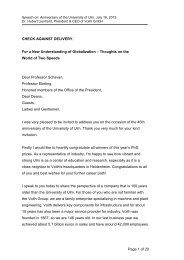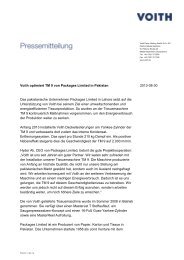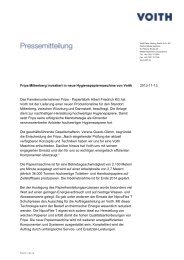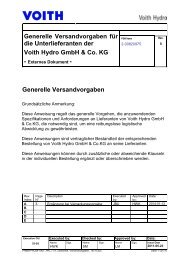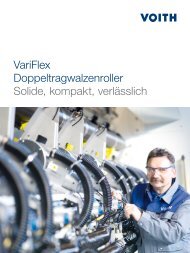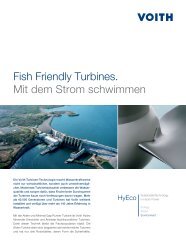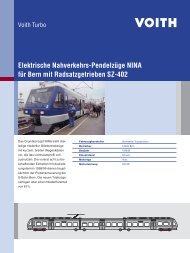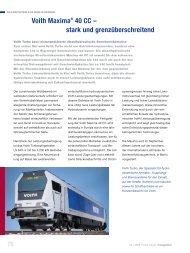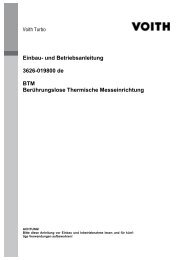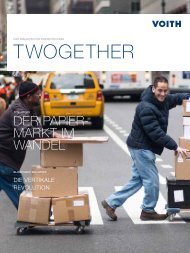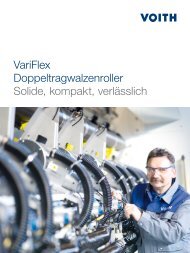Create successful ePaper yourself
Turn your PDF publications into a flip-book with our unique Google optimized e-Paper software.
6<br />
Tandem NipcoFlex<br />
500 700 kN/m<br />
Thickness 118 ÷ 122 µm<br />
Roughness 650 ÷ 750 ml/min<br />
Dryness 47 ÷ 49 %<br />
Soft Calender<br />
Thickness<br />
200 ÷ 250 kN/m<br />
> 104 µm<br />
Roughness 150 ÷ 220 ml/min<br />
Fig. 6 shows in more detail the interrelationship<br />
between the press and the<br />
calender work for a bulk sensitive woodfree<br />
copy paper (80 g/m2 ). The market<br />
often requires a specific bulk of 1.3<br />
(thickness 104 micron) at a Bendtsen<br />
roughness in the range of 150 to<br />
220 ml/min. The required specific bulk<br />
was achieved by the Tandem NipcoFlex<br />
Press of the pilot installation with linear<br />
loads of 500 to 700 kN/m. Since both<br />
paper sides have the same roughness<br />
after the press, the two soft calenders<br />
can both be loaded with approx. 200 to<br />
250 kN/m at 150°C.<br />
Considering the entire production<br />
process, the optimum combination, for<br />
this specific furnish, was a paper thickness<br />
of 120 micron with 700 ml/min<br />
Bendtsen at high dryness after press that<br />
was calendered to the target of 150 to<br />
220 ml/min at 104 micron. Generally, a<br />
lower nipload of the Tandem NipcoFlex<br />
Press has the advantage of higher bulk<br />
Twosidedness [%]<br />
40<br />
30<br />
20<br />
10<br />
0<br />
<strong>Paper</strong> Machines<br />
Bendtsen<br />
Cobb oil<br />
PPS<br />
DuoCentri NipcoFlex Tandem NipcoFlex<br />
with 3 felts<br />
with Transbelt with 4 felts<br />
and yields higher smoothness of the<br />
paper surface.<br />
The two double felted shoe presses are<br />
dewatering nearly symmetrically to top<br />
and bottom side. After extensive trials<br />
with various felt suppliers and a further<br />
development of the felt design the<br />
twosidedness in Bendtsen, PPS and oil<br />
absorption were seen to be plus minus<br />
some percent and confirm the expectations,<br />
Fig. 7. The application of a transfer<br />
belt instead of a bottom felt in the<br />
second press results as expected in a<br />
distinct deterioration with respect to<br />
twosidedness due to the different surfaces<br />
and dewatering in one direction<br />
only.<br />
Conclusion<br />
The Tandem NipcoFlex Press is part of<br />
many linerboard machines since years.<br />
In the meantime, this concept was developed<br />
further for printing & writing<br />
grades. The drawless sheet run is a big<br />
Fig. 6: Inter-relationsship of press and calender<br />
work.<br />
Fig. 7: Twosidedness.<br />
35<br />
advantage, especially for low basis<br />
weights (ULWC), despite a minor rewetting.<br />
At medium basis weights (newsprint,<br />
SC), the low twosidedness, reduced<br />
number of breaks and the speed<br />
potential are very advantageous. At high<br />
basis weights the Tandem NipcoFlex<br />
Press allows, aside from the already<br />
mentioned benefits, much higher dryness.<br />
In summary, the Tandem NipcoFlex<br />
Press, with four felts and two shoe<br />
presses, is, because of all the mentioned<br />
advantages, in many applications the<br />
most desirable and most economical<br />
solution:<br />
■ high dry content and high specific<br />
bulk with two NipcoFlex presses<br />
■ four felts for minimal twosidedness<br />
■ low paper expansion<br />
■ suction rolls for controlled and safe<br />
web run, short threading time.<br />
With the new Tandem NipcoFlex Press<br />
<strong>Voith</strong> Sulzer will set new benchmarks in<br />
speed, efficiency and paper quality.<br />
7





